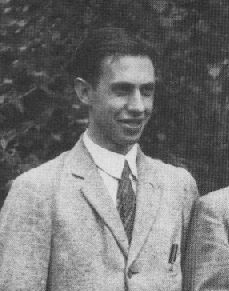George Uhlenbeck facts for kids
Quick facts for kids
George Uhlenbeck
|
|
|---|---|

Uhlenbeck c. 1928
|
|
| Born |
George Eugene Uhlenbeck
December 6, 1900 Batavia, Dutch East Indies (now Jakarta)
|
| Died | October 31, 1988 (aged 87) |
| Nationality | American |
| Alma mater | University of Leiden |
| Known for | Electron spin Ornstein–Uhlenbeck process Quantum Boltzmann equation |
| Children | Olke C. Uhlenbeck |
| Awards | Oersted Medal (1955) Max Planck medal (1964) Lorentz Medal (1970) National Medal of Science (1977) Wolf Prize in Physics (1979) |
| Scientific career | |
| Fields | Physicist |
| Institutions | Columbia University MIT University of Michigan Rockefeller Institute Princeton University |
| Doctoral advisor | Paul Ehrenfest |
| Doctoral students | Max Dresden George W. Ford Emil Konopinski Edwin Albrecht Uehling Seth Putterman |
| Influenced | Walter S. Huxford |
George Eugene Uhlenbeck (born December 6, 1900 – died October 31, 1988) was a famous Dutch-American theoretical physicist. He is best known for his important discovery of the electron spin. This idea helped us understand how tiny particles behave.
Contents
Early Life and Learning
George Uhlenbeck was born in 1900. His parents were Eugenius and Anne Beeger Uhlenbeck. He went to high school in The Hague, Netherlands, and finished in 1918.
He first studied chemical engineering at Delft University of Technology. But after a year, he switched to Leiden University to study physics and math. He earned his bachelor's degree in 1920.
At Leiden, a very important scientist named Paul Ehrenfest invited George to his weekly physics discussions. Ehrenfest became a huge influence on George's scientific journey. From 1922 to 1925, George worked as a tutor in Rome. There, he met another famous physicist, Enrico Fermi, who became a lifelong friend. George got his master's degree from Leiden in 1923.
In 1925, George returned to Leiden to help Ehrenfest. Ehrenfest asked him to work with a student named Samuel Goudsmit. Their task was to quickly learn about new ideas in physics. In September 1925, George and Samuel made a groundbreaking discovery: they introduced the idea of electron spin. This means that electrons, tiny particles, have their own built-in "spin" or rotation. This was a huge step in understanding how atoms work.
In 1927, George earned his Ph.D. from Leiden University. His thesis was about "Statistical Methods in the Quantum Theory." He also married Else Ophorst in the Netherlands that same year.
Working as a Physicist
In 1927, Uhlenbeck started teaching physics at the University of Michigan in the United States. He stayed there for eight years. During this time, he helped organize popular "Summerschools" for theoretical physics.
In 1938, he visited Columbia University in New York City as a professor. Because of the rise of Nazism in Europe, George and his wife Else decided to move back to America permanently in 1939. He returned to the University of Michigan.
During World War II, from 1943 to 1945, Uhlenbeck led a group working on radar research. Radar was very important for the war effort. After the war, he went back to the University of Michigan. In 1960, he moved to the Rockefeller Institute (now Rockefeller University) in New York City.
Uhlenbeck also developed an important idea in physics called the Ornstein-Uhlenbeck process. This process helps describe how things move randomly, like tiny particles in a liquid.
Later Years and Legacy
George Uhlenbeck retired in 1971. However, he continued to be involved in science until the early 1980s. He passed away on October 31, 1988, in Boulder, Colorado, at 87 years old.
Awards and Honors
Uhlenbeck received many awards for his amazing contributions to physics. He was given five honorary degrees. Some of his major awards include:
- The Oersted Medal in 1955.
- The Max Planck Medal in 1964.
- The Lorentz Medal in 1970.
- The National Medal of Science in 1977 (shared with Samuel Goudsmit).
- The Wolf Prize in Physics in 1979.
He was also elected to important groups like the Royal Netherlands Academy of Arts and Sciences and the United States National Academy of Sciences.
George Uhlenbeck was friends with many great scientists of his time, including Enrico Fermi. His student, E.G.D. Cohen, described Uhlenbeck's work as clear, precise, and focused on understanding basic problems in physics. Cohen also said that Uhlenbeck was an inspiring teacher. He taught several generations of physicists about statistical mechanics, making complex ideas easy to understand.
See also
 In Spanish: George Eugene Uhlenbeck para niños
In Spanish: George Eugene Uhlenbeck para niños
- Ornstein–Uhlenbeck process



